Мой фотоаппарат Canon S120
Содержание
Wi-Fi wonders and woes
As mentioned there’s Wi-Fi included to share pictures, and Canon’s given this feature a bit of a reworking. It’s still not perfect, but we no longer struggle to share images. A previous complaint we had with the earlier Wi-Fi implementation was its inability to share directly with third party apps — everything went through Canon’s Image Gateway instead.
That’s no longer the case. We’ve posted images to Facebook and Twitter direct from Canon’s Camera Window app, where it’s possible to get camera and smart device to talk to one another. The initial set-up process requires all the usual password entry which can be a little slow, but the camera’s touchscreen helps to speed up this process.
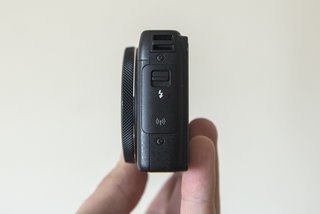
However the six-section interface, which presents the various methods of sharing via six access point symbols, is a little confusing to look at. There are no words. Literally no words. So two symbols that look like a computer, one that looks like a camera, another like a smartphone and a camera won’t necessarily help you without having a quick flick through the manual. Yup, sacrilege, we know. Furthermore each of these access points requires individual WEP password entry, it’s not a one-entry-fits-all process, and that makes the process altogether much longer. More secure, but more irksome.
Overall the Wi-Fi interface still needs smoothing out, and it’s not the effortless process of something like the Samsung Galaxy Camera, but it’s a step in the right direction. We found it usable and, indeed, useful.
READ: Samsung Galaxy Camera review
However, Wi-Fi will impact on battery life. And as we were only snapping around 200 or so shots per charge it’s fairly limited in terms of on-going available power anyway. So, if anything, Wi-Fi is best avoided when out and about. We were hoping for some new miracle battery to give the S120 added pep, but that’s not the case.
Picture perfect
A big reason to buy a high-end compact camera is for its image quality. You’re the kind of person that wants a dedicated camera, not a swanky smartphone that claims to be as good as a camera (and doesn’t deliver on that claim). If that’s you then the S120 is the perfect match in most regards, with a handful of quibbles thrown in along the way.

The S120 offers sensitivity from ISO 80 to ISO 12,800, which is usable and largely noise free from ISO 80-800, even if there’s always some presence of non-disruptive grain throughout. Sometimes it’s hard to tell the lower ISO settings from the mid-level ones, depending on the shot, which is testament to how well it performs.
Even at ISO 1600 the results are still fairly decent, although the camera opts for low shutter speeds in Auto rather than amping up the ISO by default. The addition of an ever-so-slightly wider aperture compared to the S110 also assists in keeping the ISO sensitivity down a notch.
Step things up to ISO 3200 and there’s the inevitable extra push of colour noise and resulting image softness. JPEG files do counteract this, but with considerable impact to sharpness. We think the grainier shots look all the better really, and would make great black and white conversions.
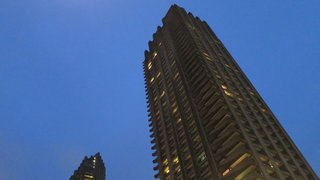
Is the S120 streets ahead of the S110? Not really, but then we can’t bemoan that. At this level upgrades are subtle rather than mind-blowing, but fortunately the S120 is as close as a sensor of this size has got to perfection. It does have its work cut out against the larger sensors found in the Sony Cyber-shot RX100 II, or Fujiiflm X20, but then the Canon succeeds in balancing physical body size, resolution and mostly sustainable quality throughout much of its ISO range. It’s a top notch all-rounder, something that can’t be levelled at much of the competition.
READ: Sony Cyber-shot RX100 II review
There are some shortcomings though, mainly in the form of overexposure. We found it all too common for shots to have blown-out highlights in the typical metering scenarios which was a bit of a nuisance. Shoot raw and there’s a level of correction against this, of course, which is something we’ve been delving into quite a bit. The files cope well with exposure adjustment in post production.

The drop in available aperture at the longer end of the zoom — the maxium of f/5.7 at 120mm isn’t exactly great for low-light conditions — also can’t match up to the likes of the Panasonic Lumix LX7.
READ: Panasonic Lumix LX7 review
Sharpness, too, can be a bit hit and miss, dependent on processing. And there are signs of purple fringing (chromatic aberration) towards subject edges. All things to keep in mind when making that purchase choice.
Overall, if you’re after decent image quality in a small package then little else out there can rival the Canon PowerShot S120. It’s a little cracker, with only minor quibbles, even if it doesn’t make the earth move compared to its previous iteration. But it’s still an all-round winner, particularly in those low-mid ISO settings.
Verdict
If you’re looking for a small, pocketable yet high-end compact camera that produces cracking images then there aren’t many other places to look than directly at the PowerShot S120 or Panasonic Lumix LX7.
The Canon does itself justice in being a decent all-rounder. It may be small in the hand, but it’s big on features and its image quality easily rivals any models of a similar sensor size. In fact it probably betters them. We’re big fans of the customisable lens control ring too and the S120 is a true step ahead of its S110 predecessor in the performance stakes. If you’re a few generations of S-series behind and are thinking of sticking with the brand then now will probably feel like a good point to jump on board.
But it’s not quite perfect. We’d like to see a stronger battery performance, there’s some overexposure in shots that’s a bit of a nuisance, while the Wi-Fi mode — while certainly better — needs to be polished up before it’s a perfectly smooth runner. Not to mention that it’s just as pricey as ever, but that’s an inevitability. Even so, it puts the S120 firmly in the Fujifilm X20 ballpark and makes that purchase decision that much tougher if you’re a brand new buyer. In that instance it’ll probably come down to physical size.
And if small is top of your list then the S120 is very likely to be the number one choice. And with good reason: it’s a truly great high-end compact camera.
Ring-A-Ding-Ding
The lens ring is one of our favourite features of the Canon S120. It can be used to adjust pretty much any setting you happen to want, as adjusted from within the camera’s menu or when left to default it adjusts the most relevant setting based on the selected mode. For example, aperture priority sees the lens ring shift through aperture, for shutter priority it adjusts shutter speed, in Auto it’s used for step-zoom, while in Programme mode it takes command of ISO sensitivity. The click-through-turn sensation when rotating the ring is ideal for aperture selection or step-zoom control. We like.
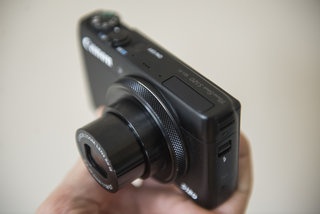
In addition the S120 has a rear d-pad that rotates to act as a secondary dial for selecting options. Ideal for use in manual mode, or for when you have the front lens ring always set to a specific mode at your preference.
In use we’re fond of the touch-sensitive 3-inch screen and the ability to quickly and easily select a focus area with just a single tap. Autofocus speed has seen a reworking so now — finally — the PowerShot S120 is as competitive as any other high-end compact out there. If not better. That’s not to say that the S110 was slow, but the S120 takes that speed and gives it a kick up the backside to the tune of a 50 per cent speed improvement. And even if our brains aren’t able to measure how accurate this figure is (as it’s the one provided by Canon) what we do know for sure is that it feels like a step forward. If you’re from the S100, S95 or earlier stage then now might be a great time to look at upgrading to the S120 — you’ll notice the difference straight away.
Whether you want full manual control or camera automation then you’re in luck, as everything is catered for via the main mode dial. Point-and-shoot autofocus sticks to its decent face-detection system that we found to work effortlessly, while close-up focus as near as 3cms from the lens at the widest-angle setting puts macro shots easily within your shooting repertoire.
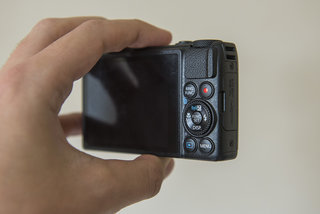
Elsewhere features are just as strong as ever: raw & JPEG file options; 1080p video capture; built-in Wi-Fi for picture sharing; GPS (global positioning satellite) for geotagging images. It’s a veritable feast of feature goodies.
Canon PowerShot S120 Review
By: Kyle Schurman
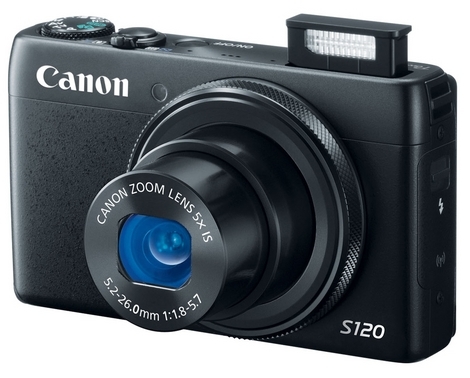
Review posted 04/02/2014
| Quick Take |
| Pros |
|
| Cons |
|
| Bottom Line |
| Canon has created a very likable pocket-sized advanced fixed-lens camera with its PowerShot S120 model. This camera creates great images and works faster than its predecessor, thanks to the impressive DIGIC 6 image processor. The S120 minimizes shutter lag and provides a very impressive burst mode of about 10 frames per second. You’ll find a sharp and bright touchscreen LCD with the S120 as well as built-in Wi-Fi, although both of these features could be better designed. Poor battery life, a limited 5x optical zoom lens, the lack of a hot shoe, and a high price hold the S120 back a little bit, but it’s still an impressive thin camera. Read more in our Full Conclusion. |
Canon’s pocket-sized PowerShot S120 is the successor to the S110. The S120 features a 12.1-megapixel High-Sensitivity CMOS image sensor, a 5x (24-120mm) wide angle zoom lens with an f/1.8-f/5.7 aperture, a DIGIC 6 image processor, improved Auto Focus speeds, up to 12.1 frames-per-second continuous shooting, and 1080/60p Full HD video record with a built-in stereo microphone and HDMI output.
The PowerShot S120 also includes built-in Wi-Fi to transfer still images and video to places like Facebook, Twitter, Flickr, and YouTube. Interestingly, there are actually three ways to use the S120’s Wi-Fi:
- Connect the S120 to a PC over a local Wi-Fi network.
- Connect the S120 to the CANON iMAGE GATEWAY online photo album.
- Connect the S120 to a smartphone or tablet running the Canon CameraWindow app (available for iOS and Android). This app also allows users to control the S120 remotely.
The PowerShot S120 also boasts Canon’s Smart AUTO technology as well as a number of Creative Shot Modes. Smart AUTO automatically chooses between 58 pre-defined scenes based on shooting conditions to ensure proper exposure. And the Creative Modes are things like HDR (High Dyanmic Range), the all new Star Mode which takes both long exposure stills and time-lapse movies of night skies, and a Background Defocus mode, which approximates shallow depth-of-field.
Canon PowerShot S120 Features:
- 12.1-megapixel High-Sensitivity CMOS image sensor (1/1.7″ type)
- 5x optical zoom lens
- DIGIC 6 processor
- Continuous High Speed Capture of up to 12.1 frames-per-second
- Full 1080/60p HD Video
- Creative Shot Modes
- Star Mode
- Background Defocus
- Handheld HDR Scene
- Smart AUTO Technology
- Built-in Wi-Fi
- Canon Camera Window app
- CANON iMAGE GATEWAY
- Li-ion battery pack (rated up to 260 shots)
- SD card slot
Canon’s PowerShot S120 has a suggested retail price of $449.99. It’s available in any color, so long as it’s black. What’s in the box?:
- PowerShot S120 Digital Camera
- Battery Pack NB-6LH
- Battery Charger CB-2LY
- Wrist Strap WS-DC11
Additional Product Views
Introduction
The Canon PowerShot S120 is a pocket-sized camera that offers a lot of professional features. Aimed at the serious photographer looking for a capable compact, the Canon S120 features a high-sensitivity 12.1 megapixel 1/1.7-type CMOS sensor, 5x zoom lens with a focal range of 24-120mm and fast maximum aperture of f/1,8, new DIGIC 6 processor, fast auto-focusing of 0.1 seconds, and a 3-inch touchscreen LCD display with an improved resolution of 922K dots. The S120 also offers a maximum ISO of 12,800 at full resolution, built-in wi-fi connectivity, GPS functionality via pairing with a smartphone, 1080p movie recording at 60fps, full range of manual shooting modes, RAW format support and faster 12.1fps burst shooting. Also present are the innovative lens Control Ring, which enables users to adjust the settings of various functions by twisting the selector at the base of the lens barrel to the left or right, a built-in Neutral Density Filter, a 4-stop optical Intelligent Image Stabilizer with five-axis Enhanced Dynamic IS mode during movie recording, two new Creative Filters and improved HDR mode capabilities. Available in black or silver, the Canon Powershot S120 officially retails for £449.99 / €529.99 / $449.99.
Описание модели

Внешних отличий у камеры от предыдущей модели практически нет. Если камеры поставить рядом, то при беглом их осмотре вы можете даже не понять, где из них какая. Вся разница будет заключаться лишь в гордой надписи в нижнем левом углу на лицевой стороне фотоаппарата, которая будет гласить, что Canon PowerShot SX120 IS обладает 10 Мп.

Корпус фотоаппарата изготовлен из прочного пластика с матовым покрытием черного цвета, что убережет камеру от появления отпечатков пальцев. Также небольшие царапины, если таковые и появятся в процессе эксплуатации, будут практически незаметны на его поверхности. Сам материал добротный и не вызывает особых нареканий.
На передней панели корпуса расположились встроенный объектив, индикатор подсветки автофокуса и встроенный микрофон.

Объектив оснащён 10-кратным оптическим трансфокатором с фокусным расстоянием 6,0 – 60,0 мм (36 — 360 мм в 35-мм эквиваленте). Его конструкция состоит из десяти элементов в 9 группах.

Что касается габаритов, то камера имеет средние показатели — 110,6 x 70,4 x 44,7 мм при весе в 245 грамм. Это, конечно же, больше чем, у какого-нибудь Canon IXUS, но зато намного меньше, чем у представителей класса гиперзумов.


На левой боковой панели корпуса под резиновой заглушкой спрятался отсек для установки батарейки типа CR1220, которая отвечает за правильность выставления времени и даты в камере.


На правой же панели также под резиновой заглушкой спрятались разъёмы – DC IN, A/V OUT и DIGITAL. Первый из них отвечает за возможность питания камеры от внешнего источника. Второй служит для подключения к аудио-видео устройствам, а третий предназначен для передачи отснятого материала на компьютер.

Чуть ли не все основные органы управления камеры расположились на верхней панели корпуса. В правой его части сосредоточились кнопка включения-выключения камеры, кнопка спуска затвора, имеющая у своего основания каретку управления трансфокатором и диск выбора режимов съёмки. Встроенный динамик в свою очередь разместился в крайнем левом углу.

Рядом с ним, но ближе к центру нашла своё место встроенная вспышка. Чтобы ей воспользоваться, пользователю придётся поднимать её вручную.

На нижней панели корпуса традиционно расположилось гнездо для крепления штатива. Оно несколько смещено вправо относительно оси объектива.

В правой части нижней панели корпуса под пластмассовой крышкой спрятался сдвоенный разъём для карт памяти и источников питания. В комплект поставки входят две щелочные батарейки типоразмера АА.

Запись осуществляется на карты памяти типа SD, SDHC, SDXC, MMC, MMCplus, HC MMCplus. С аппаратом поставляется SD-карта емкостью 128 Мб.

Для более комфортного визирования производитель наградил своё детище 3-дюймовым дисплеем с разрешением в 230 000 пикселей и пятью уровнями регулировки яркости. Сама матрица экрана защищена толстым стеклом, которое убережёт ее от появления царапин.

Оставшиеся элементы управления камеры расположились правее от дисплея на задней панели корпуса. В верхней части находится кнопка для перехода в режим просмотра отснятого материала. Под ней мы видим кнопку, отвечающую за переход в режим интеллектуального портрета и рядом с ней кнопку внесения экспокоррекции, которая по совместительству ещё и даёт возможность для удаления снимков при их просмотре. На одном уровне с ними находится индикатор, показывающий, когда происходит обращение к карте памяти. Ниже заметен пятипозиционный переключатель, который можно как крутить, для выбора режима, так и нажимать. В его обязанности входит управление работой встроенной вспышки, настройка параметров таймера, а также переход в режимы ручной фокусировки и макро. Дополнительно он отвечает за настройку режимов чувствительности и переход в подменю FUNC. И в самом низу отведено специальное место для ещё двух кнопок управления. Первая (DISP.) служит для отображения параметров съёмки, а вторая (MENU) отвечает за переход в основное меню камеры.
Характеристики
Тип матрицы
CMOS
Форм-фактор
1/1,7″
Разрешение эфф.
12,1 млн пикс.
Процессор
Digic 6
Макс. размер кадра
4000×3000 точек
Соотношение сторон
4:3, 3:2, 16:9, 1:1
Запись RAW
есть
Форматы файлов
RAW, JPEG
Оптика
Фокусные расстояния
24—120 мм
Оптический зум
5×
Цифровое увеличение
4×
Значения диафрагмы
F1,8/F5,7
Стабилизация
оптическая
Фокусировка
Типы фокусировки
автоматическая по контрасту; ручная
Автофокусировка
AiAF 9-точечная с распознаванием лиц, выбором зоны или объекта на экране и слежением, 1-точечная с выбором положения или по центру; установка размера зоны
Зон автофокуса
9
Минимальная дистанция
0,03 м
Непрерывная АФ
есть
Брекетинг по фокусировке
нет
Подсветка автофокуса
есть
Фотографические функции
Чувствительность
авто, 80—12 800 ISO
1/2500—250 с
Экспозамер
многозонный, центровзвешенный, точечный
Управление экспозицией
авто, приоритет диафрагмы, приоритет выдержки, ручное; 9 сюжетных программ
Компенсация экспозиции
±3 EV с шагом 1/3 ступени
Эксповилка
±2,0 EV с шагом 1/3 ступени
Баланс белого
7 пресетов, по образцу
Серийная съемка
12,1 кадров/с, 5 JPEG в серии
Особенности
после заполнения буфера 9,4 кадра/с до 635 снимков; при активном автофокусе 5,5 кадра/с, при «живом» просмотре 5,6 кадра/с
Запись видео
1920×1080 точек, 60 кадров/с
Особенности
режимы скоростной съемки: 640×480 точек, 120 кадров/с, 320×240, 240 кадров/с; с эффектом «миниатюра» до 6 кадров/с; длительность ролика 29 м 59 с или до 4 Гб на файл, в скоростных режимах до 30 с
MPEG-4/AVC/H.264
Форматы файлов
MOV (H.264, звук AAC-LC стерео)
Управление экспозицией
есть
Скоростная съемка
есть
Стабилизация
есть
Оптический зум при записи
есть
Вспышка
Встроенная вспышка
есть
Дальность действия
от 0,5 до 5,0 м
Внешняя вспышка
нет
Режимы работы
авто, заполняющая, медленная синхронизация; компенсация экспозиции ±2 EV с шагом в 1/3 ступени, автокоррекция с привязкой к распознаванию лиц; ручная настройка мощности (3 шага)
нет
Дисплей
3,0 дюйма, 922 тыс. пикс., TFT
Поворотное крепление
нет
Тачскрин
да
Встроенная память
нет
SD, SDHC, SDXC с поддержкой UHS
Физические характеристики
Защита от внешней среды
нет
Габариты, Ш×В×Г
100×59×29 мм
Вес
217 граммов
Питание
литиево-ионный аккумулятор NB-6LH
Автономность
230 кадров
Порты и связь
USB-порт
mini USB тип B
HDMI-порт
mini HDMI
Встроенный Wi-Fi
есть
Функции беспроводной связи
IEEE802.11b/g/n (2,4 ГГц); подключение к ПК, беспроводная печать, подключение к телефону, получение GPS-данных (с приложением Canon)
Пульт ДУ
есть
Прочие особенности
GPS-модуль
нет
Датчик ориентации
есть
Автоспуск
2, 10 с, по улыбке, по подмигиванию, по новому лицу в кадре
Встроенный RAW-конвертер
нет
Truly compact
Here’s the thing about the Canon S120: it’s small; a truly pocketable device. People won’t ask if there’s a banana in your pocket. That can’t be said for plenty of other «compact» cameras, such as the larger-brother PowerShot G16, or even the likes of the Fujifilm X20 — as much as we have considerable praise for both those models.
READ: Canon PowerShot G16 hands-on
At first glance there’s no external difference between the S120 and the earlier S110 model, except for the obvious shift of name badge. Look extra close and you will spot a slight upgrade in the lens department: the 24-120mm range’s maximum aperture is now f/1.8-5.7 (not f/2.0-5.9 as before) which translates into an additional third stop of light. A modest benefit, but a benefit nonetheless — it looks like Canon is squeezing everything that it can out of this small body size, and that wide aperture at the wide-angle setting is exactly the sort of thing a high-end product such as this needs.

In the hand the S120’s build quality shines through too. It feels sturdy and reassuringly weighty, without being too heavy, while small details such as the metal lens ring and mode dial give it a sense of luxury. It’s understated in the best of ways, so to the unsuspecting it doesn’t look like a high-end compact camera — and that means it can be used discreetly without attracting too much attention.
The camera’s body has a slight textured finish to assist with grip, but that’s one possible gripe — there’s no proper front grip, while the rear is limited to a small thumb rest. We didn’t find it a problem when holding the camera, in that it didn’t come flying out of our hands, but if you’re old skool and like a protruding grip then you won’t get one here — but that’s the nature of this camera in the interests of keeping things small.
There’s a recurring theme here: size. All this talk of small doesn’t carry through when looking at the big features under the S120’s skin. The 12.2-megapixel 1/1.7-inch sensor at the camera’s core might not be as large as that in the Fujifilm X20, but it’s still of proven capability and the S120’s latest Digic 6 processor promises a step up in speed and quality terms.
READ: Fujifilm X20 review
